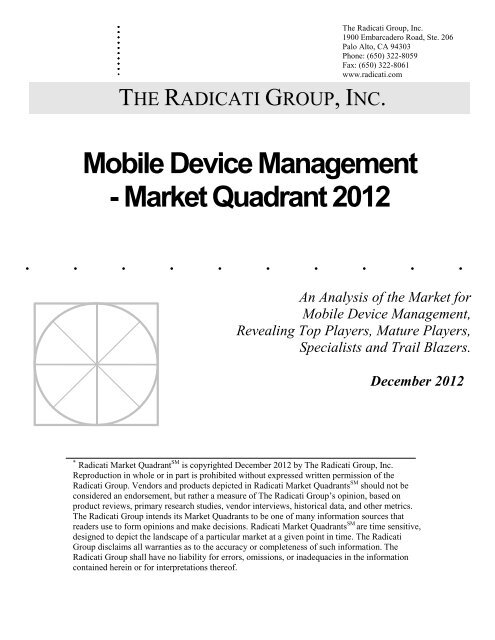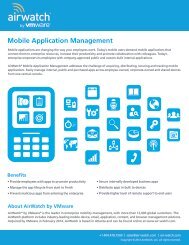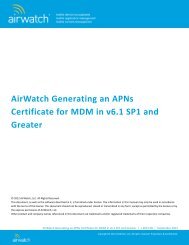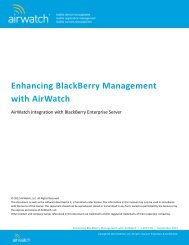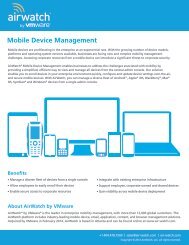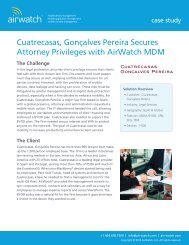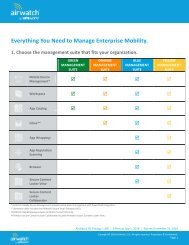Download - AirWatch
Download - AirWatch
Download - AirWatch
Create successful ePaper yourself
Turn your PDF publications into a flip-book with our unique Google optimized e-Paper software.
.<br />
THE RADICATI GROUP, INC.<br />
The Radicati Group, Inc.<br />
1900 Embarcadero Road, Ste. 206<br />
Palo Alto, CA 94303<br />
Phone: (650) 322-8059<br />
Fax: (650) 322-8061<br />
www.radicati.com<br />
Mobile Device Management<br />
- Market Quadrant 2012<br />
. . . . . . . . . .<br />
An Analysis of the Market for<br />
Mobile Device Management,<br />
Revealing Top Players, Mature Players,<br />
Specialists and Trail Blazers.<br />
December 2012<br />
Radicati Market Quadrant SM is copyrighted December 2012 by The Radicati Group, Inc.<br />
Reproduction in whole or in part is prohibited without expressed written permission of the<br />
Radicati Group. Vendors and products depicted in Radicati Market Quadrants SM should not be<br />
considered an endorsement, but rather a measure of The Radicati Group’s opinion, based on<br />
product reviews, primary research studies, vendor interviews, historical data, and other metrics.<br />
The Radicati Group intends its Market Quadrants to be one of many information sources that<br />
readers use to form opinions and make decisions. Radicati Market Quadrants SM are time sensitive,<br />
designed to depict the landscape of a particular market at a given point in time. The Radicati<br />
Group disclaims all warranties as to the accuracy or completeness of such information. The<br />
Radicati Group shall have no liability for errors, omissions, or inadequacies in the information<br />
contained herein or for interpretations thereof.
Mobile Device Management - Market Quadrant 2012<br />
TABLE OF CONTENTS<br />
RADICATI MARKET QUADRANTS EXPLAINED .................................................................. 3<br />
MARKET SEGMENTATION ................................................................................................ 5<br />
EVALUATION CRITERIA ................................................................................................... 7<br />
MARKET QUADRANT – MOBILE DEVICE MANAGEMENT VENDORS ............................... 10<br />
KEY MARKET QUADRANT TRENDS ............................................................................ 11<br />
MOBILE DEVICE MANAGEMENT - VENDOR ANALYSIS .................................................. 13<br />
TOP PLAYERS ............................................................................................................. 14<br />
TRAIL BLAZERS ......................................................................................................... 20<br />
SPECIALISTS ............................................................................................................... 29<br />
MATURE PLAYERS ..................................................................................................... 33<br />
===============================================================<br />
Please note that this report comes with a 1-5 user license. If you wish to distribute the<br />
report to more than 5 individuals, you will need to purchase an internal site license for an<br />
additional fee. Please contact us at admin@radicati.com if you wish to purchase a site<br />
license.<br />
Companies are never permitted to post reports on their external web sites or distribute by<br />
other means outside of their organization without explicit written prior consent from The<br />
Radicati Group, Inc. If you post this report on your external website or release it to<br />
anyone outside of your company without permission, you and your company will be<br />
liable for damages. Please contact us with any questions about our policies.<br />
===============================================================<br />
Copyright © December 2012 The Radicati Group, Inc. Reproduction Prohibited 2
Mobile Device Management - Market Quadrant 2012<br />
RADICATI MARKET QUADRANTS EXPLAINED<br />
Radicati Market Quadrants are designed to illustrate how individual vendors fit within<br />
specific technology markets at any given point in time. All Radicati Market Quadrants<br />
are composed of four sections, as shown in the example quadrant (Figure 1).<br />
1. Specialists – This group is made up of two types of companies:<br />
a. Emerging players that are still very new to the industry and have not yet<br />
built up much of an installed base. These companies are still developing<br />
their strategy and technology.<br />
b. Established vendors that offer a niche product.<br />
2. Trail Blazers – These vendors offer cutting edge technology, but have not yet<br />
built up a large customer base. With effective marketing and better awareness,<br />
these companies hold the power to dethrone the current market leaders. “Trail<br />
blazers” often shape the future of technology with their innovations and new<br />
product designs.<br />
3. Top Players – These are the current leaders of the market, with products that<br />
have built up large customer bases. Vendors do not become “top players”<br />
overnight. Most of the companies in this quadrant were first specialists or trail<br />
blazers (some were both). As companies reach this stage, they must fight<br />
complacency and continue product innovation, or else they will be replaced by the<br />
next generation of “trail blazers.”<br />
4. Mature Player – These vendors have large, mature installed bases of customers,<br />
but no longer set the pace for the rest of the industry. These vendors are no longer<br />
considered “movers and shakers” as they once were.<br />
a. In some cases, this is by design. If a vendor has made a strategic decision<br />
to move in a new direction, it may slow development on one product line<br />
and start another.<br />
Copyright © December 2012 The Radicati Group, Inc. Reproduction Prohibited 3
Market Share<br />
High<br />
Low<br />
Mobile Device Management - Market Quadrant 2012<br />
b. In other cases, a vendor may simply become complacent as a top vendor<br />
and be out-developed by hungrier “trail blazers” and other top players.<br />
c. Companies in this stage either find new life and revive their R&D, moving<br />
back into the “top players” segment, or else they slowly fade away as<br />
legacy technology.<br />
Figure 1, below, shows a sample Radicati Market Quadrant. As a vendor continues to<br />
develop its product, it will move horizontally along the “x” axis. As market share<br />
changes, vendors move vertically along the “y” axis. It is common for vendors to move<br />
between quadrants over the life of a product, as their products improve and market<br />
requirements evolve.<br />
Radicati Market Quadrant<br />
Mature Players<br />
Top Players<br />
Company L<br />
Company Z<br />
Company Y<br />
Company J<br />
Company H<br />
Company A<br />
Specialists<br />
Low<br />
Company B<br />
Company D<br />
Company C<br />
Functionality<br />
Company E<br />
Figure 1: Sample Radicati Market Quadrant<br />
Company F<br />
Company G<br />
Trail Blazers<br />
High<br />
Functionality – is rated from 1 to 10, with 10 being the highest, and 1 – the lowest.<br />
Market Share – is assigned according to the company’s ranking in our latest<br />
annual reports, based on its user Installed Base (e.g. the company with the largest<br />
installed base market share is number 1, the one with the second largest installed<br />
base market share is number 2, etc.).<br />
Copyright © December 2012 The Radicati Group, Inc. Reproduction Prohibited 4
Mobile Device Management - Market Quadrant 2012<br />
MARKET SEGMENTATION<br />
This edition of Radicati Market Quadrants covers the Mobile Device Management<br />
market. This study looks at the Mobile Device Management market as comprising one<br />
segment:<br />
Mobile Device Management solutions – provide policy and configuration<br />
management to enterprise mobile devices, such as mobile phones and tablets,<br />
across multiple mobile operating systems. The security and protection of mobile<br />
device data, such as encryption enforcement and app containerization, are treated<br />
as inclusive aspects of MDM solutions. MDM solutions are available as onpremises<br />
software, cloud-based services, or hybrid solutions. Leading vendors in<br />
this segment include: <strong>AirWatch</strong>, BoxTone, Fiberlink, Good, MobileIron, Research<br />
In Motion, SAP, Sophos, SOTI, Symantec, Zenprise, and others.<br />
Note: For the purposes of this report, rugged devices, such as those used by fleet<br />
operations, are not included in this segmentation. This report is meant to only offer a<br />
view of the Mobile Device Management market in the context of BYOD office employee<br />
use.<br />
The mobile landscape is constantly changing. As a result, nuances exist as to how to<br />
define mobile device management. For the purposes of this report, mobile device<br />
management is defined as including security, such as encryption and app<br />
containerization, as well as all aspects of device management, such as blocking games<br />
and settings configurations.<br />
While there are mobile security solutions that focus exclusively on protecting data on the<br />
device. These solutions were not considered in this report since they only address the data<br />
aspect of mobile device management. These solutions do not cover other aspects of<br />
device protection, such as blocking access to hardware features, automating self-help for<br />
mobile devices (e.g. password reset), tracking device location, and more.<br />
Users bringing their own mobile devices, a trend referred to as Bring Your Own Device<br />
(BYOD), for use on corporate networks is increasingly driving the need for MDM<br />
solutions. Employees accessing enterprise data outside the office presents a dilemma that<br />
needs to be addressed by all security-conscious organizations. Mobile devices on a<br />
Copyright © December 2012 The Radicati Group, Inc. Reproduction Prohibited 5
Mobile Device Management - Market Quadrant 2012<br />
corporate network are usually either part of a BYOD program, or they are corporateowned<br />
and distributed. Regardless of ownership, these devices and their access to<br />
corporate data must be guarded with device wiping, encryption enforcing, and other<br />
methods.<br />
The key threat for a mobile device is data loss. Perhaps most worrisome is that nonmalicious<br />
users can inadvertently leak corporate data with their mobile device by leaving<br />
it unlocked, losing it, or via other scenarios. While malicious users will always exist and<br />
purposely pry corporate data from an organization, accidental data loss from all mobile<br />
users is a serious threat. Some of the main features included in MDM solutions, such as<br />
password enforcement and app wrapping, are all about addressing the issues of data loss.<br />
Another key threat that MDM solutions address is the misuse of a mobile device. Since<br />
mobile devices are often used outside of an enterprise, it may be tempting for users to<br />
engage in behavior that would be unacceptable in the office, such as playing games or<br />
browsing inappropriate websites. These activities may never be appropriate on a business<br />
mobile device even outside of business hours. MDM solutions can enforce policies that<br />
block this kind of activity from happening.<br />
Worldwide revenues for the MDM market will total $525 million by year-end 2012. This<br />
figure is expected to grow to over $1.1 billion by year-end 2016. This represents an<br />
average annual growth rate of about 21% over the next four years. Figure 2, shows the<br />
worldwide revenue for the Mobile Device Management market from 2012 to 2016.<br />
Worldwide MDM Revenues ($M), 2012-2016<br />
$1,200<br />
$1,000<br />
$800<br />
$787<br />
$952<br />
$1,123<br />
$600<br />
$400<br />
$525<br />
$645<br />
$200<br />
$0<br />
2012 2013 2014 2015 2016<br />
Figure 2: Worldwide Mobile Device Management Revenue, 2012-2016<br />
Copyright © December 2012 The Radicati Group, Inc. Reproduction Prohibited 6
Mobile Device Management - Market Quadrant 2012<br />
EVALUATION CRITERIA<br />
Mobile Device Management vendors are positioned in the quadrant, according to two<br />
criteria: Market Share and Functionality.<br />
Market Share – is based on the installed base published in our “Mobile Device<br />
Management Market, 2012-2016” report. The Mobile Device Management vendor with<br />
the largest installed base has a market share of 1, the one with the second largest installed<br />
base has a market share of 2, etc. In order for a provider to be positioned in the Top<br />
Player or Mature quadrants, they need to have a market share of 1 to 5. Mobile Device<br />
Management vendors with smaller installed bases are positioned either in the Trail<br />
Blazer, or Specialist quadrants.<br />
Functionality – we assess each Mobile Device Management vendor’s solution based on a<br />
number of key differentiators in capabilities.<br />
Some of the capabilities of an MDM solution are considered fairly standard since nearly<br />
every vendor offers them. Many of these features have been commoditized with little or<br />
no differentiation between solutions. The following is a list of basic capabilities that are<br />
available in all MDM solutions:<br />
Remote device wipe is one of the most fundamental aspects of MDM solutions<br />
that allow organizations to remove corporate data from devices for a variety of<br />
reasons, such as an out of compliance device or a device that simply needs to be<br />
retired. Wipe settings can usually be set for all data on the device or just for<br />
corporate data, an ideal approach for enterprises with a BYOD environment.<br />
While some device wipes are dependent on a network connection to the MDM<br />
solution, other MDM solutions offer device wiping for any non-compliant device,<br />
regardless of network access. After a device is wiped, that mobile device has<br />
effectively completed its enterprise lifecycle and may be repurposed or reenrolled<br />
in the organization’s MDM solution.<br />
Hardware control features let MDM solutions block access to specific usage of<br />
hardware contained on the device, such as a camera, microphone, Bluetooth, or<br />
other features.<br />
Copyright © December 2012 The Radicati Group, Inc. Reproduction Prohibited 7
Mobile Device Management - Market Quadrant 2012<br />
Password enforcement can require users to lock their mobile devices with a<br />
numeric or alphanumeric password. Minimum standards can be set for password<br />
length, password type (e.g. alphanumeric), or how often until the password must<br />
be entered again.<br />
Location services offer device tracking (typically subject to user approval) and a<br />
history of a device’s location sometimes referred to as “bread-crumbing.”<br />
Location-aware policy is becoming a more common feature that allows MDM<br />
solutions to enforce certain policies based on a device’s location, such as blocking<br />
camera access while at a specific location.<br />
Active Directory (AD) synchronization lets businesses synchronize their Active<br />
Directory (AD) servers with their MDM solution for a simpler, quicker way to<br />
provision users and groups.<br />
Provisioning and enrollment should contain as much automation as possible.<br />
Most vendors automate provisioning with directory services, such as Active<br />
Directory, that can automatically apply policies based on group membership of<br />
users. Enrollment, however, still requires some sort of user interaction. Users are<br />
typically required to click on a link, install an app, or perform some sort of other<br />
simple task to complete enrollment.<br />
The following aspects of an MDM solution are considered more advanced and are<br />
key differentiating areas for Top Players and Trail Blazers:<br />
Management consoles should provide an intuitive interface that allows<br />
administrators to perform MDM provisioning and management tasks with a high<br />
degree of granularity and ease. Device analytics can also be an important aspect<br />
of the management interface in MDM solutions.<br />
App wrapping (containerization) is becoming a more important feature that lets<br />
businesses deploy custom apps to their employees with specialized data security,<br />
such as encryption, or other features that can usually be implemented via an SDK<br />
available from the MDM vendor.<br />
Copyright © December 2012 The Radicati Group, Inc. Reproduction Prohibited 8
Mobile Device Management - Market Quadrant 2012<br />
Enterprise app stores give businesses a central place to give their employees<br />
access to custom-created, wrapped apps. Enterprise app stores also usually feature<br />
commonly used apps in an effort to make favored apps more easily available<br />
instead of having employees have to hunt in their respective native app stores.<br />
Customer support is a key area where vendors can differentiate themselves. Most<br />
MDM vendors offer a support team that is available 24x7 to answer questions via<br />
phone or email. Availability, localization, pricing, and other factors should be<br />
evaluated for customer support satisfaction. For cloud-based solutions, customer<br />
guarantees in the form of Service Level Agreements (SLAs) should also come<br />
standard with at least a 99.9% uptime guarantee.<br />
Helpdesk automation usually provides a self-service portal that users can access<br />
to perform basic MDM functions, such as device wiping, password resetting, and<br />
more. Simple tasks like these can bog down IT administrators that ought to spend<br />
their time tackling more complex problems. Automating these features and giving<br />
users the ability to solve them can translate to large amounts of savings for IT<br />
departments.<br />
Flexible deployment options let businesses choose between cloud-based, onpremises,<br />
private cloud, or other deployment options. Most MDM vendors can<br />
offer a variety of deployment scenarios.<br />
Note: On occasion, we may put a player on the right side of the quadrant by giving them<br />
a higher than typical Functionality Score, even if they are missing one or two of the<br />
features mentioned above, if we feel that the other aspects of their solution are<br />
particularly unique and innovative.<br />
Copyright © December 2012 The Radicati Group, Inc. Reproduction Prohibited 9
Market Share<br />
High<br />
Low<br />
Mobile Device Management - Market Quadrant 2012<br />
MARKET QUADRANT – MOBILE DEVICE MANAGEMENT VENDORS<br />
Mobile Device Management Market Quadrant, 2012<br />
Mature Players<br />
Top Players<br />
RIM<br />
<strong>AirWatch</strong><br />
Good<br />
MobileIron<br />
SAP<br />
Zenprise<br />
BoxTone<br />
Symantec<br />
Fiberlink<br />
SOTI<br />
Specialists<br />
Low<br />
Sophos<br />
Functionality<br />
Trail Blazers<br />
High<br />
Figure 3: Mobile Device Management Market Quadrant, 2012<br />
Radicati Market Quadrant SM is copyrighted December 2012 by The Radicati Group, Inc.<br />
Reproduction in whole or in part is prohibited without expressed written permission of the<br />
Radicati Group. Vendors and products depicted in Radicati Market Quadrants SM should not be<br />
considered an endorsement, but rather a measure of The Radicati Group’s opinion, based on<br />
product reviews, primary research studies, vendor interviews, historical data, and other metrics.<br />
The Radicati Group intends its Market Quadrants to be one of many information sources that<br />
readers use to form opinions and make decisions. Radicati Market Quadrants SM are time<br />
sensitive, designed to depict the landscape of a particular market at a given point in time. The<br />
Radicati Group disclaims all warranties as to the accuracy or completeness of such information.<br />
The Radicati Group shall have no liability for errors, omissions, or inadequacies in the<br />
information contained herein or for interpretations thereof.<br />
Copyright © December 2012 The Radicati Group, Inc. Reproduction Prohibited 10
Mobile Device Management - Market Quadrant 2012<br />
KEY MARKET QUADRANT TRENDS<br />
<strong>AirWatch</strong>, MobileIron, and Good rank as Top Players in the Mobile Device<br />
Management market.<br />
o <strong>AirWatch</strong> is one of the largest pure-play vendors in the MDM space. The<br />
vendor is often one of the first to release new leading-edge features due to<br />
its large team of developers. <strong>AirWatch</strong> is ideal for large enterprises that<br />
wish to take advantage of its robust enterprise integration tools that extend<br />
to email, directory sync services, secure content viewing, and much more.<br />
o MobileIron’s focus on preserving the native mobile operating system<br />
experience has brought the vendor a lot of success in the MDM space. Its<br />
Virtual Smartphone Platform (VSP) and Connected Cloud give<br />
organizations flexible options to protect their mobile environments,<br />
including legacy platforms. In addition, MobileIron’s recent transition to<br />
offer management features for Apple Mac OS X devices is seen as an<br />
excellent move since enterprises often prefer one vendor that can monitor<br />
all endpoints.<br />
o Good’s focus is mostly around the secure collaboration piece of protecting<br />
mobile devices in the enterprise. In August 2012, however, Good released<br />
its standalone MDM solution, Good Mobile Manager, that targets a<br />
different market that is more interested in the fundamental aspects of<br />
MDM. This new solution lets Good potentially grow its installed base by<br />
appealing to this new set of customers. At the same time, Good is also<br />
expanding its core secure collaboration capabilities with its acquisition of<br />
Copiun.<br />
Zenprise, BoxTone, Fiberlink, and SOTI rank as Trail Blazers. These companies<br />
offer a comprehensive range of services and are innovators in the Mobile Device<br />
Management market, however, do not yet have the large market share that would<br />
position them as Top Players. As these companies build momentum and grow<br />
their installed base, they are likely to move into the Top Player quadrant.<br />
Copyright © December 2012 The Radicati Group, Inc. Reproduction Prohibited 11
Mobile Device Management - Market Quadrant 2012<br />
o Zenprise offers an on-premises and cloud-based solution that can also be<br />
combined for a hybrid deployment. Zenprise’s MDM solution offers<br />
robust device management features with a particular focus on securing<br />
data on the device and keeping that data from being exposed outside the<br />
enterprise. These features in the Zenprise MDM solutions make them ideal<br />
for enterprises with a few hundred users and up.<br />
o BoxTone is a clear leader for MDM deployments in large organizations.<br />
BoxTone customers can take advantage of the vendor’s solutions’<br />
capabilities to integrate with larger enterprise systems, such as Microsoft<br />
System Center Operations Manager (SCOM) and HP Operations Manager<br />
(HPOM), to make management across an organization easier. Even<br />
without integrating with larger enterprise systems, the native automated<br />
helpdesk, device analytics, and other features in BoxTone’s solutions<br />
make it fully capable of handling large enterprise deployments.<br />
o Fiberlink has focused its MDM solution to being deployed exclusively in<br />
the cloud. While other vendors have cloud-based offerings, Fiberlink is the<br />
only major MDM player that is exclusively deployed in the cloud. This<br />
lets Fiberlink devote all of its resources to a single platform that it knows<br />
well. Fiberlink is able to give its customers a complete MDM solution<br />
with plenty of functionality that even extends to protect enterprise systems<br />
running Apple Mac OS X or Microsoft Windows.<br />
o SOTI is a leader in MDM capabilities for Google Android devices. The<br />
vendor is also a leader in solutions that offer MDM for rugged devices.<br />
SOTI is investing heavily in Google Android technology and is at the<br />
forefront of offering MDM features for Android devices.<br />
Symantec and Sophos are in the Specialist quadrant. These companies have a<br />
loyal client base, but have been less aggressive in coming out with new features<br />
and functionality. Moreover, their overall market share is also somewhat limited.<br />
o Symantec’s MDM solution has received an injection of new capabilities with<br />
its Nukona acquisition. Nukona’s technology was the basis of the Symantec<br />
App Center that gives enterprises those critical mobile application<br />
Copyright © December 2012 The Radicati Group, Inc. Reproduction Prohibited 12
Mobile Device Management - Market Quadrant 2012<br />
management capabilities. Symantec is now able to offer a powerful MDM<br />
solution that can protect the mobile enterprise. The solution does have a few<br />
drawbacks, such as its lack of an automated helpdesk, but this can be<br />
overlooked in certain circumstances, especially for customers that are already<br />
deploying Symantec solutions for their other enterprise IT needs.<br />
o Sophos first introduced its MDM solution in April 2011. Most other major<br />
MDM vendors had offered solutions long before Sophos introduced its line of<br />
offerings. The Sophos MDM solutions remain in a nascent phase as they<br />
continue to be developed and updated with new features, but Sophos’ ability<br />
to bundle traditional endpoint security solutions with its MDM offering is<br />
exactly what a lot of customers are looking for.<br />
RIM and SAP are Mature Players. They each have a large installed base but do not<br />
offer highly innovative solutions.<br />
o RIM is able to offer MDM capabilities for a variety of the mobile<br />
operating systems used in the enterprise today, such as Apple iOS and<br />
Google Android. While this makes RIM more competitive in its ability to<br />
cater to the inevitable multi mobile operating system deployments in the<br />
enterprise, a complete MDM solution from RIM involves a complex<br />
server deployment and is still heavily favored towards RIM BlackBerry<br />
devices instead of all platforms.<br />
o SAP Afaria is just one of many solutions that SAP currently offers in the<br />
enterprise, and it brings all the expected functionality of an MDM<br />
solution. SAP Afaria’s latest update focused on helpdesk and automation<br />
features, which is exactly where the vendor should be investing given its<br />
customers’ preference for BYOD deployments. SAP still needs to improve<br />
its solution a little further, such as implementing a simpler management<br />
interface, before it can be considered a Top Player.<br />
Copyright © December 2012 The Radicati Group, Inc. Reproduction Prohibited 13
Mobile Device Management - Market Quadrant 2012<br />
MOBILE DEVICE MANAGEMENT - VENDOR ANALYSIS<br />
TOP PLAYERS<br />
AIRWATCH<br />
1155 Perimeter Center West, Suite 100<br />
Atlanta, GA 30338<br />
www.air-watch.com<br />
<strong>AirWatch</strong> was founded in 2003 with a focus on mobile security solutions. The company<br />
is privately held with financial backing from its executives and has not received any<br />
outside funding. <strong>AirWatch</strong> continues to focus on mobile security solutions, but it has<br />
expanded support to include devices running Apple Mac OS X. <strong>AirWatch</strong> solutions are<br />
deployed by customers of all sizes, but there is more of a tendency towards larger<br />
enterprises.<br />
The vendor currently offers a Mobile Device Management solution that includes mobile<br />
application and email management along with BYOD support. The <strong>AirWatch</strong> solution<br />
provides security for most mobile operating systems, including Apple iOS, Google<br />
Android, RIM BlackBerry, Microsoft Windows Phone, Microsoft Windows Mobile, and<br />
Nokia Symbian. The MDM solution can enforce encryption, passwords, Web usage,<br />
remote view, remote control, automated helpdesk, and more. Organizations can choose to<br />
deploy the MDM solution as a multi-tenant SaaS or on-premises with perpetual and<br />
subscription licenses available for both methods.<br />
Optionally, organizations can subscribe to <strong>AirWatch</strong>’s Mobile Content Management<br />
solution that securely delivers corporate content to mobile devices. MCM comes with<br />
25GB of cloud-based storage and provides mobile users with access to enterprise and<br />
personal content repositories.<br />
FUNCTIONALITY: 9<br />
MARKET SHARE: 2<br />
Copyright © December 2012 The Radicati Group, Inc. Reproduction Prohibited 14
Mobile Device Management - Market Quadrant 2012<br />
KEY STRENGTHS:<br />
With a headcount approaching 900 employees and over 300 dedicated to R&D,<br />
<strong>AirWatch</strong> employs one of the largest teams of developers of any of the pure-play<br />
MDM vendors.<br />
<strong>AirWatch</strong> offers strong integration with enterprise systems and resources, such as<br />
an Active Directory synchronization tool, an SDK for integrating <strong>AirWatch</strong><br />
security and management features into custom enterprise apps, and more.<br />
<strong>AirWatch</strong> also offers a secure content viewing application that integrates with<br />
Microsoft SharePoint and network file shares.<br />
<strong>AirWatch</strong> provides robust support for email access and management, such as<br />
Microsoft Office 365 integration, Microsoft Exchange Server integration, and<br />
more.<br />
KEY WEAKNESSES:<br />
The management dashboard for <strong>AirWatch</strong> is not customizable.<br />
<strong>AirWatch</strong> does not support the S/MIME authentication protocol for Google<br />
Android devices.<br />
The SDK available to integrate <strong>AirWatch</strong> security and management features into<br />
custom enterprise apps is only available for Apple iOS devices.<br />
Copyright © December 2012 The Radicati Group, Inc. Reproduction Prohibited 15
Mobile Device Management - Market Quadrant 2012<br />
MOBILEIRON<br />
415 East Middlefield Rd<br />
Mountain View, CA 94043<br />
www.mobileiron.com<br />
MobileIron was founded in 2007. The company has over 400 employees, and has<br />
received funding from Sequoia Capital and other investment firms. MobileIron focuses<br />
exclusively on securing and managing mobile apps, documents, and devices.<br />
MobileIron offers two key MDM solutions: MobileIron Virtual Smartphone Platform<br />
(VSP) for on-premises deployments and MobileIron Connected Cloud for cloud-based<br />
deployments. MobileIron Connected Cloud offers support for Apple iOS and Google<br />
Android. MobileIron VSP offers support for the same platforms, but it adds support for<br />
RIM BlackBerry, Nokia Symbian, and others. It also adds support for Apple Mac OS X<br />
systems. MobileIron’s solutions are managed from a customizable console called the<br />
MobileIron Atlas. For larger deployments, administration can be delegated based on<br />
region, device type, or other factors. MobileIron customers tend to be larger businesses<br />
with 500 employees or more.<br />
FUNCTIONALITY: 9<br />
MARKET SHARE: 3<br />
KEY STRENGTHS:<br />
MobileIron focuses on preserving the native user experience on mobile devices.<br />
This keeps mobile devices as they were intended to be accessed by the user.<br />
MobileIron contains DLP features for mobile devices, such as preventing<br />
distribution of certain documents, copy and pasting controls, and more.<br />
MobileIron seamlessly integrates with multiple email platforms, such as<br />
Microsoft Exchange, Microsoft Office 365, and others.<br />
Copyright © December 2012 The Radicati Group, Inc. Reproduction Prohibited 16
Mobile Device Management - Market Quadrant 2012<br />
KEY WEAKNESSES:<br />
MobileIron Connected Cloud currently only offers support for Apple iOS and<br />
Google Android. Support for Microsoft Windows Phone 8 will be added in late<br />
2012.<br />
Although multiple MobileIron Virtual Smartphone Platforms can be managed via<br />
a central Atlas console, the solution does not cluster for deployments larger than<br />
100,000 devices.<br />
Copyright © December 2012 The Radicati Group, Inc. Reproduction Prohibited 17
Mobile Device Management - Market Quadrant 2012<br />
GOOD<br />
430 N. Mary Ave, Suite 200<br />
Sunnyvale, CA 94085<br />
www.good.com<br />
Good was founded in 1996, and in 2009 was purchased by and merged with Visto, a<br />
provider of email and messaging products for mobile devices. In 2012, Good acquired<br />
Copiun, a provider of mobile collaboration solutions. Good also subsequently acquired<br />
AppCentral, an early market entrant in app wrapping and enterprise app stores. Good<br />
offers solutions focused on secure messaging, file access, file sharing and instant<br />
messaging, as well as a complete enterprise mobility management solution comprising<br />
MDM, MAM, and app security. The majority of Good’s customers are larger<br />
organizations that place a high priority on securing mobile devices and the data on those<br />
devices.<br />
Good offers three different MDM solutions that protect mobile devices in the enterprise:<br />
Good for Enterprise is a suite of tools that includes secure messaging, secure<br />
Web browsing, application management, and MDM features for Apple iOS,<br />
Google Android, and Windows Phone devices.<br />
Good Dynamics includes a mobile app security SDK and app wrapping<br />
technology that allows organizations to add additional application security and<br />
management features, such as encryption and secure data exchange between apps.<br />
The SDK and wrapping technology can implement Good’s underlying security<br />
framework in custom-built apps.<br />
Good Mobile Manager is Good’s standalone MDM offering that is designed for<br />
organizations that do not need access to secure collaboration features. Good<br />
Mobile Manager can enforce the fundamental MDM capabilities, such as<br />
password enforcement. Additionally, Good recently partnered with Boxtone to<br />
jointly deliver enhanced MDM and MAM capabilities—such as comprehensive<br />
service management, sophisticated analytics, and unified reporting—so that<br />
enterprise customers can enhance the health, ROI, and compliance of their<br />
mobility deployments.<br />
Copyright © December 2012 The Radicati Group, Inc. Reproduction Prohibited 18
Mobile Device Management - Market Quadrant 2012<br />
FUNCTIONALITY: 7<br />
MARKET SHARE: 4<br />
KEY STRENGTHS:<br />
Good offers robust security features that enable organizations to protect mobile<br />
devices and offer secure collaboration, such as additional encryption capabilities,<br />
containerization of apps, and other security features.<br />
Good Dynamics lets organizations implement single sign-on (SSO) between<br />
containerized apps for interoperability between the apps and a more streamlined<br />
workflow.<br />
Good for Enterprise has powerful data loss prevention (DLP) features, such as<br />
restricting cut, copy, and pasting between apps and enabling “Open In” by policy<br />
for only IT specified apps.<br />
Good recently released the Good Mobile Manager solution for customers that do<br />
not need secure collaboration features. Good Mobile Manager lets these<br />
customers opt for a simpler MDM solution that is less expensive.<br />
KEY WEAKNESSES:<br />
Good does not natively support RIM BlackBerry devices. They are only<br />
supported through integration with Boxtone.<br />
Good does not offer a cloud-based solution for a more flexible deployment.<br />
Good does not offer integration with major cloud-based email service providers,<br />
such as Microsoft Office 365. Integration with Microsoft Office 365 is expected<br />
sometime in the first quarter of 2013.<br />
The management dashboards contained in Good’s MDM solutions are not yet<br />
fully customizable.<br />
Copyright © December 2012 The Radicati Group, Inc. Reproduction Prohibited 19
Mobile Device Management - Market Quadrant 2012<br />
TRAIL BLAZERS<br />
ZENPRISE<br />
1600 Seaport Blvd, Suite 200<br />
Redwood City, CA 94063<br />
www.zenprise.com<br />
Zenprise was founded in 2003 and is privately held with backing from Greylock Partners,<br />
Mayfield Fund, and other investors. Zenprise competes exclusively in the enterprise<br />
MDM and mobile IT market.<br />
Zenprise offers two MDM solutions: Zenprise MobileManager 8.0 and Zencloud that<br />
can protect Apple iOS, Google Android, RIM BlackBerry, Microsoft Windows Mobile,<br />
and Nokia Symbian devices. The two solutions offer identical features with the only<br />
difference being the deployment method. Zencloud is deployed exclusively as a private<br />
or public cloud, while Zenprise MobileManager 8.0 can be deployed on-premises or in a<br />
hybrid mode. Zenprise is used in multiple verticals with interest coming mostly from<br />
medium and large businesses.<br />
Zenprise also offers a mobile security solution called Zensuite, which offers IT the<br />
ability to secure and manage mobile content across content repositories, email, intranets,<br />
and apps. Zensuite must be deployed alongside Zenprise MobileManager 8.0 or<br />
Zencloud.<br />
FUNCTIONALITY: 8<br />
MARKET SHARE: 6<br />
KEY STRENGTHS:<br />
The Zenprise architecture is secure and enterprise-grade and is designed for<br />
highly-available and scalable deployments. Unlike many MDM solutions,<br />
Zenprise does not store or cache LDAP data in the DMZ layer, avoiding the risk<br />
Copyright © December 2012 The Radicati Group, Inc. Reproduction Prohibited 20
Mobile Device Management - Market Quadrant 2012<br />
of personally identifiable information from being lost or stolen.<br />
Zenprise offers its Mobile DLP solution for data loss prevention as a seamless<br />
addition to Zenprise MobileManager 8.0 or Zencloud. Mobile DLP includes<br />
secure content access and integrates with Microsoft SharePoint.<br />
Zenprise’s mobile secure content viewer includes an annotation tool that lets users<br />
markup PDF files in Microsoft SharePoint. Any edited file is created as a new file<br />
in Microsoft SharePoint.<br />
KEY WEAKNESSES:<br />
Zensuite does not plan on support for Windows Phone until early 2013.<br />
Zenprise does not currently have FIPS certification for its MDM solutions.<br />
The document annotation feature is only currently available on Apple iOS<br />
devices.<br />
Copyright © December 2012 The Radicati Group, Inc. Reproduction Prohibited 21
Mobile Device Management - Market Quadrant 2012<br />
BOXTONE<br />
8825 Stanford Blvd, Suite 200<br />
Columbia, MD 21045<br />
www.boxtone.com<br />
BoxTone entered the MDM space in 2005. The company is privately held and is backed<br />
by Lazard Technology Partners and other investors. BoxTone’s core offerings are all<br />
focused around securing and managing mobile IT.<br />
BoxTone offers four mobile management solutions as part of its Enterprise Mobility<br />
Management (EMM) solution:<br />
Mobile Device Management focuses on delivering device level controls on<br />
Apple iOS, Google Android, Microsoft Windows Phone, and RIM BlackBerry<br />
devices. BoxTone’s MDM solution features automated policy and compliance<br />
engine, device wiping, application management, passcode enforcement,<br />
encryption enforcement, and more. MDM is typically deployed on-premises.<br />
Mobile App Management provides policy-driven full lifecycle app control via<br />
its enterprise app catalog to deploy, update, track and retire applications. In<br />
addition, BoxTone lets businesses develop with custom SDK or app wrapping for<br />
additional security measures. Apps can be created with custom rules for<br />
authentication, DLP, on device encryption, OTA encryption, and more.<br />
Additionally, apps can be blacklisted or whitelisted to enforce corporate policies.<br />
Mobile Support Management is a solution available to help bring more<br />
automation to the IT helpdesk. MSM helps by automatically diagnosing problems<br />
on user’s mobile devices for faster helpdesk calls.<br />
Mobile Operations Management gives businesses tools to monitor the status of<br />
their MDM deployment. The solution can be used to monitor and analyze service<br />
quality and device usage patterns, alerting IT of issues that may be causing<br />
problems in a network and providing recommendations on how to tune<br />
performance.<br />
Copyright © December 2012 The Radicati Group, Inc. Reproduction Prohibited 22
Mobile Device Management - Market Quadrant 2012<br />
Perpetual licenses are sold for each of the solutions that are typically deployed onpremises.<br />
Most BoxTone customers are large enterprises in heavily regulated<br />
industries, such as banking, government, healthcare, oil & gas/utilities, and retail.<br />
FUNCTIONALITY: 7<br />
MARKET SHARE: 7<br />
KEY STRENGTHS:<br />
BoxTone’s solutions use an auto-discovery agent to integrate with Microsoft<br />
Active Directory servers, document servers, application servers, and more. These<br />
integrations allow IT to leverage existing group policy and simplify management<br />
via integration with other IT processes.<br />
Integration is also offered for complex systems management and other databases,<br />
such as Microsoft System Center Operations Manager (SCOM) and HP<br />
Operations Manager (HPOM), which are common in larger enterprises.<br />
Incorporating these system management solutions lets IT departments take<br />
advantage of existing investments in staff and processes.<br />
BoxTone offers app containerization with DLP.<br />
KEY WEAKNESSES:<br />
Though they are designed for specific user roles and workflows, the dashboards in<br />
BoxTone’s solutions are not customizable.<br />
BoxTone offered customers a promotional low cost subscription-based model for<br />
its solution in the summer of 2012, but the vendor does not typically offer such<br />
aggressive pricing.<br />
Copyright © December 2012 The Radicati Group, Inc. Reproduction Prohibited 23
Mobile Device Management - Market Quadrant 2012<br />
BoxTone provides strong integration and has key advantages managing RIM<br />
BlackBerry devices, but these competitive advantages may become less attractive<br />
as enterprises continue to adopt Apple iOS and Google Android.<br />
Copyright © December 2012 The Radicati Group, Inc. Reproduction Prohibited 24
Mobile Device Management - Market Quadrant 2012<br />
FIBERLINK<br />
1787 Sentry Parkway West<br />
Building Eighteen, Suite 200<br />
Blue Bell, PA 19422<br />
www.MaaS360.com<br />
Fiberlink was founded in 1991, and first introduced a solution with MDM capabilities in<br />
2010. The provider is backed by GE Capital, Goldman Sachs, and other investors. Today,<br />
Fiberlink focuses on its MDM solution that also offers an option to protect Microsoft<br />
Windows and Apple Mac OS X systems.<br />
Fiberlink offers one solution called MaaS360 (mobile-as-a-service) that is entirely cloudbased.<br />
MaaS360 is made up of several different add-ons, with the core MDM piece<br />
providing protection for Apple iOS, Google Android, RIM BlackBerry, Microsoft<br />
Windows Phone, and Nokia Symbian devices. Mobile application management (MAM),<br />
secure document sharing, email access controls, WiFi and VPN security, and mobile<br />
expense management functionality can all be added to a MaaS360 deployment on a<br />
subscription basis. The Fiberlink cloud attracts customers of different sizes, ranging from<br />
a few seats to tens of thousands of seats in multiple verticals.<br />
FUNCTIONALITY: 9<br />
MARKET SHARE: 8<br />
KEY STRENGTHS:<br />
Fiberlink has a tool called the MaaS360 Cloud Extender that integrates with<br />
Microsoft Exchange ActiveSync and can block new, unregistered mobile devices<br />
from accessing email. The tool can also integrate with Microsoft Office 365 and<br />
IBM Lotus Notes.<br />
Fiberlink offers an SDK called AppExtender that can integrate the security<br />
features in MaaS360, such as authentication, into custom-built enterprise apps on<br />
mobile devices.<br />
Copyright © December 2012 The Radicati Group, Inc. Reproduction Prohibited 25
Mobile Device Management - Market Quadrant 2012<br />
MaaS360 has a secure document sharing application that utilizes Fiberlink’s<br />
proprietary cloud content delivery system, MaaS360 Doc Cloud, to give mobile<br />
users access to enterprise content.<br />
KEY WEAKNESSES:<br />
Fiberlink does not offer an on-premises solution for customers that may require a<br />
more secure deployment.<br />
Access to secure cloud content is optimized for Fiberlink’s MaaS360 Doc Cloud<br />
service. Integration with other cloud content systems is only available for<br />
Microsoft SharePoint.<br />
Copyright © December 2012 The Radicati Group, Inc. Reproduction Prohibited 26
Mobile Device Management - Market Quadrant 2012<br />
SOTI<br />
5700 Hurontario St.<br />
Suite 1100, Mississauga,<br />
Ontario L5R 3G5<br />
Canada<br />
www.soti.com<br />
SOTI is a privately held MDM vendor with offices in Canada, the US, the UK, and<br />
Australia. SOTI is a long-time leader in the rugged device market. In 2008 the company<br />
expanded its solutions to manage consumer and BYOD enterprise mobile devices.<br />
SOTI’s MDM offering is its MobiControl solution. MobiControl can manage and<br />
protect Apple iOS, Google Android, RIM BlackBerry, Microsoft Windows Mobile<br />
devices, as well as computers running Apple`s and Microsoft`s Desktop and Server<br />
operating systems. MobiControl can be deployed in the cloud, on-premise, or as a<br />
managed solution. MobiControl has a wide array of features that range from setting<br />
BYOD policies to advanced management features, such as GeoFencing and Helpdesk<br />
functionality. While SOTI’s solutions can support a broad range of devices, the majority<br />
of its customers use MobiControl to manage Apple iOS and Google Android devices, but<br />
SOTI also has many customers who use the solution to manage rugged devices that run<br />
Microsoft`s Windows Mobile operating system. Due to SOTI’s advanced Android+<br />
technology SOTI is also commonly deployed in enterprises that have a need to manage<br />
Google Android devices. MobiControl is deployed in businesses of all sizes and across<br />
multiple verticals.<br />
FUNCTIONALITY: 8<br />
MARKET SHARE: 9<br />
KEY STRENGTHS:<br />
SOTI has a technology called Android+ that allows for OEMs to offer a common<br />
set of management features that can be added by an OEM at any time. These<br />
features include anti-virus, remote control, silent software deployment/removal,<br />
Copyright © December 2012 The Radicati Group, Inc. Reproduction Prohibited 27
Mobile Device Management - Market Quadrant 2012<br />
and other enhanced policies.<br />
SOTI can integrate with Microsoft Active Directory for simpler policy<br />
management across an organization. SOTI also offers robust encryption for data<br />
on mobile devices that is FIPS certified.<br />
SOTI includes Web filtering in its MobiControl solution that can create<br />
white/black lists for websites, browsing rules by category, and more.<br />
SOTI has an SDK available to wrap iOS apps for additional MDM features, such<br />
as remote viewing and access to the wrapped application’s file directory over the<br />
air.<br />
KEY WEAKNESSES:<br />
The enterprise is beginning to standardize on Apple iOS, but SOTI continues to<br />
invest more heavily behind development of mobile management features for<br />
Google Android devices.<br />
SOTI currently has exclusive access to some MDM features on Samsung devices<br />
running Google Android since it helped develop the features with Samsung. If<br />
this exclusivity expires, SOTI will lose this differentiating factor, however it will<br />
still have an advantage over other MDM vendors that will need to develop<br />
functionality around these features from scratch.<br />
Copyright © December 2012 The Radicati Group, Inc. Reproduction Prohibited 28
Mobile Device Management - Market Quadrant 2012<br />
SPECIALISTS<br />
SYMANTEC<br />
350 Ellis St<br />
Mountain View, CA 94043<br />
www.symantec.com<br />
Symantec is a publicly traded company that was founded in 1982. In addition to mobile<br />
security solutions, the vendor also specializes in endpoint security, backup, availability,<br />
and other similar solutions for consumers and the enterprise. In 2012, Symantec acquired<br />
Nukona for its mobile application management technology. Symantec also acquired<br />
Odyssey in 2012 for its MDM technologies.<br />
Symantec Mobile Management Suite (SMMS) is a mobile device management offering<br />
that is made up of a variety of modular solutions: Symantec Mobile Management 7.2<br />
(SMM) for core mobile device management; Symantec App Center for mobile<br />
application management; and Symantec Mobile Security for increased security<br />
protection, such as anti-malware and secure browsing. SMMS offers management<br />
features for Apple iOS, Google Android, and Microsoft Windows Mobile devices.<br />
Symantec App Center is available in the cloud, but the rest of the components of<br />
Symantec’s SMMS are only available on-premises. Symantec is typically deployed by<br />
organizations of all sizes, with an emphasis on organizations that are larger than 2,000<br />
seats.<br />
FUNCTIONALITY: 5<br />
MARKET SHARE: 8<br />
KEY STRENGTHS:<br />
SMM can be integrated with Symantec’s endpoint management solution,<br />
Symantec Endpoint Management for a more convenient deployment to protect all<br />
endpoints in the enterprise.<br />
Copyright © December 2012 The Radicati Group, Inc. Reproduction Prohibited 29
Mobile Device Management - Market Quadrant 2012<br />
The Symantec App Center lets organizations containerize apps to keep corporate<br />
data separate from personal data.<br />
Symantec offers a secure content delivery system via SMM and the Symantec<br />
App Center that can give employees access to applications, documents, links, and<br />
more.<br />
KEY WEAKNESSES:<br />
SMM does not offer a self-service portal for users to perform basic mobile device<br />
management functions, such as resetting a passcode. Users with a problem will<br />
always be required to submit a helpdesk ticket that can drain IT sources for small<br />
tasks.<br />
The content delivery system included with Symantec Mobility Management Suite<br />
is limited to files less than 25 MB.<br />
Symantec does not offer a single-sign-on feature to let containerized apps<br />
communicate with each other and easily exchange data.<br />
Copyright © December 2012 The Radicati Group, Inc. Reproduction Prohibited 30
Mobile Device Management - Market Quadrant 2012<br />
SOPHOS<br />
3 Van de Graaff Drive<br />
Burlington, MA 01803<br />
www.sophos.com<br />
Sophos is a privately held company with offices in the US, UK, Canada, Australia,<br />
Singapore, Germany, and elsewhere. The vendor offers a range of data loss prevention<br />
(DLP), anti-virus, UTM, encryption, and other security solutions for desktops, servers,<br />
mobile devices, and more. Sophos’ variety of solutions are used by enterprises of all sizes<br />
in all verticals. In 2012, Sophos acquired DIALOGS, an MDM vendor, for its mobile<br />
security technology.<br />
Sophos protects mobile devices with three solutions:<br />
Sophos Mobile Control (SMC) is Sophos’ main MDM offering that provides<br />
security for Apple iOS, Google Android, RIM BlackBerry, and Microsoft<br />
Windows Mobile devices. SMC includes encryption enforcement, password<br />
enforcement, device wiping, and other MDM capabilities. SMC is available onpremises<br />
or as a cloud-based service.<br />
Sophos Mobile Encryption (SME) provides secure, device-based encrypted<br />
access to cloud content on Apple iOS or Google Android devices.<br />
Sophos Mobile Security (SMS) is a solution that is offered as a free app<br />
download for Google Android devices. SMS runs anti-virus scans and other core<br />
MDM features, such as device location services. The solution is partly designed to<br />
give potential users a preview of Sophos’ more sophisticated offerings.<br />
FUNCTIONALITY: 4<br />
MARKET SHARE: 10<br />
Copyright © December 2012 The Radicati Group, Inc. Reproduction Prohibited 31
Mobile Device Management - Market Quadrant 2012<br />
KEY STRENGTHS:<br />
Sophos can provide customers a broad range of security services beyond MDM,<br />
such as endpoint security, data loss prevention (DLP), and much more. Many<br />
MDM vendors are pure-play providers that can only offer support for mobile<br />
devices.<br />
Sophos recently acquired DIALOGS, a German-based MDM vendor. DIALOGS’<br />
MDM technology will be used to improve upon and introduce new features into<br />
Sophos’ MDM solutions, such as improvements around secure collaboration.<br />
The SME solution gives users a tool for securely viewing documents in the cloud.<br />
SME currently supports Dropbox.<br />
KEY WEAKNESSES:<br />
The cloud-based version of SMC loses some functionality over the on-premises<br />
version, such as support for RIM BlackBerry devices, direct LDAP integration,<br />
and more.<br />
Sophos has limited app data protection capabilities since it does not support the<br />
containerization or wrapping of apps.<br />
Integration with Microsoft Office 365 is not currently offered.<br />
Copyright © December 2012 The Radicati Group, Inc. Reproduction Prohibited 32
Mobile Device Management - Market Quadrant 2012<br />
MATURE PLAYERS<br />
RESEARCH IN MOTION<br />
295 Phillip Street<br />
Waterloo, Ontario<br />
Canada N2L 3W8<br />
www.rim.com<br />
Research in Motion (RIM) was founded in 1984, and is publicly traded on the Toronto<br />
Stock Exchange. With offices around the world, RIM offers a variety of mobile products<br />
and solutions mostly focused on its BlackBerry platform, such as its BlackBerry<br />
Playbook tablet, BlackBerry Messenger service, and more.<br />
RIM has three available mobile solutions that support MDM functionality:<br />
RIM BlackBerry Enterprise Server (BES) manages RIM BlackBerry<br />
smartphones. BES supports email integration, encryption features, and application<br />
management. Core MDM functionality, such as device wiping and many other<br />
features are part of BES.<br />
RIM BlackBerry Device Service (BDS) manages RIM BlackBerry Playbook<br />
tablets with similar features that are included in the BES solution.<br />
RIM Universal Device Service (UDS) manages Apple iOS and Google Android<br />
devices. The UDS solution includes core MDM functionality, such as<br />
management of connection settings, applications, and more.<br />
The management of these three solutions can be integrated into one interface via the RIM<br />
BlackBerry Mobile Fusion (BMF) solution. Although RIM also offers MDM<br />
capabilities for Apple iOS and Google Android devices, RIM’s solutions are targeted at<br />
large enterprises that have large deployments of RIM BlackBerry smartphones and<br />
tablets.<br />
Copyright © December 2012 The Radicati Group, Inc. Reproduction Prohibited 33
Mobile Device Management - Market Quadrant 2012<br />
FUNCTIONALITY: 3<br />
MARKET SHARE: 1<br />
KEY STRENGTHS:<br />
Many organizations already deploy BES servers for email access. Using BES for<br />
its MDM capabilities simplifies enterprise deployments by not adding another<br />
vendor.<br />
RIM BlackBerry Balance technology is available with RIM’s MDM solutions that<br />
separates personal and corporate data. RIM BlackBerry Balance is ideal for<br />
BYOD environments.<br />
The RIM BlackBerry Enterprise Server has a Google Apps plug-in to integrate<br />
with the cloud service.<br />
KEY WEAKNESSES:<br />
Enrollment for the RIM BlackBerry Playbook cannot be completed over the air. It<br />
must be activated with the BDS while physically connected to a computer.<br />
Many of the MDM features available for RIM BlackBerry devices are not<br />
available for Apple iOS or Google Android devices, such as silent application<br />
installation.<br />
Depending on the environment, there may need to be as many as four separate<br />
servers to provide a complete MDM solution with a unified management interface<br />
for an enterprise.<br />
Copyright © December 2012 The Radicati Group, Inc. Reproduction Prohibited 34
Mobile Device Management - Market Quadrant 2012<br />
SAP<br />
Dietmar-Hopp-Allee 16<br />
69190 Walldorf<br />
Germany<br />
www.sap.com<br />
SAP is a global software developer that is publicly traded on the Frankfurt Stock<br />
Exchange. SAP’s current line of MDM solutions is based on technology from Sybase, a<br />
company that SAP acquired in 2010. In mid-2012, SAP announced an agreement with<br />
Amazon to host SAP’s cloud-based Afaria solution in the Amazon cloud, Amazon Web<br />
Services (AWS). In 2012, SAP also announced that it acquired Syclo, a developer of<br />
enterprise mobile applications.<br />
The SAP Afaria 7.0 solution manages app, content, and device features for Apple iOS,<br />
Google Android, and Windows Mobile devices. The same feature set that AWS offers<br />
with SAP Afaria is also available on-premises. Most enterprises deploy SAP Afaria to<br />
keep personal and corporate data separate on mobile devices via a variety of methods,<br />
such as custom enterprise-specific apps. SAP Afaria is targeted at organizations of all<br />
sizes that have adopted a BYOD strategy.<br />
FUNCTIONALITY: 5<br />
MARKET SHARE: 5<br />
KEY STRENGTHS:<br />
SAP has a tremendous amount of resources, such as capital and intellectual<br />
property, to further the capabilities of SAP Afaria. SAP’s recent acquisition of<br />
Syclo and movement into mobile content management with investments in Box<br />
and Alfresco will also help further functionality in the solution.<br />
SAP offers numerous other mobile solutions that are deployed in the enterprise,<br />
which makes it convenient for customers wanting to deploy SAP Afaria alongside<br />
Copyright © December 2012 The Radicati Group, Inc. Reproduction Prohibited 35
Mobile Device Management - Market Quadrant 2012<br />
other SAP solutions.<br />
SAP Afaria provides detailed reporting and activity usage on mobile devices that<br />
the solution manages. Reporting details are also leveraged through SAP’s<br />
Business Objects software for actionable business intelligence information.<br />
KEY WEAKNESSES:<br />
For a more secure cloud-based deployment, customers must ask SAP to build a<br />
custom cloud delivery system that is more expensive than deployment in<br />
Amazon’s cloud. Most customers will rely on service via Amazon, which may not<br />
be as secure as SAP deploying its own public cloud delivery system for SAP<br />
Afaria.<br />
SAP Afaria offers support for most major mobile operating systems, but it<br />
currently lacks support for Microsoft Windows Phone devices.<br />
Some large-scale installations of SAP Afaria can be very complex and may not<br />
allow implementing policies as simply as compared to other MDM solutions.<br />
Copyright © December 2012 The Radicati Group, Inc. Reproduction Prohibited 36
Mobile Device Management - Market Quadrant 2012<br />
THE RADICATI GROUP, INC.<br />
http://www.radicati.com<br />
The Radicati Group, Inc. is a leading Market Research Firm specializing in emerging IT<br />
technologies. The company provides detailed market size, installed base and forecast<br />
information on a worldwide basis, as well as detailed country breakouts, in all areas of:<br />
Email<br />
Security<br />
Instant Messaging<br />
Unified Communications<br />
Identity Management<br />
Web Technologies<br />
The company assists vendors to define their strategic product and business direction. It<br />
also assists corporate organizations in selecting the right products and technologies to<br />
support their business needs.<br />
Our market research and industry analysis takes a global perspective, providing clients<br />
with valuable information necessary to compete on a global basis. We are an international<br />
firm with clients throughout the US, Europe and the Pacific Rim.<br />
The Radicati Group, Inc. was founded in 1993, and is headquartered in Palo Alto, CA,<br />
with offices in London, UK.<br />
Consulting Services:<br />
The Radicati Group, Inc. provides the following Consulting Services:<br />
Management Consulting<br />
Whitepapers<br />
Strategic Business Planning<br />
Product Selection Advice<br />
TCO/ROI Analysis<br />
Multi-Client Studies<br />
To learn more about our reports and services,<br />
please visit our website at www.radicati.com.<br />
Copyright © December 2012 The Radicati Group, Inc. Reproduction Prohibited 37
Mobile Device Management - Market Quadrant 2012<br />
MARKET RESEARCH PUBLICATIONS<br />
The Radicati Group, Inc. develops in-depth market analysis studies covering market size,<br />
installed base, industry trends and competition. Current and upcoming publications include:<br />
Currently Released:<br />
Title Released Price*<br />
Mobile Device Management Market, 2012-2016 Nov. 2012 $3,000.00<br />
Email Market, 2012-2016 Oct. 2012 $3,000.00<br />
eDiscovery Market, 2012-2016 Oct. 2012 $3,000.00<br />
Messaging Platforms Market, 2012-2016 Oct. 2012 $3,000.00<br />
Corporate IT and Business User Survey, 2012-2013 Sept. 2012 $3,000.00<br />
Hosted Email and Collaboration Market, 2012-2016 Aug. 2012 $3,000.00<br />
Information Archiving Market, 2012-2016 July 2012 $3,000.00<br />
Microsoft Office 365- Analysis and Forecast, 2012-2016 June 2012 $3,000.00<br />
Social Media Market, 2012-2016 June 2012 $3,000.00<br />
Endpoint Security Platforms, 2012-2016 May 2012 $3,000.00<br />
Enterprise Content Management Market, 2012-2016 Apr. 2012 $3,000.00<br />
Email Statistics Report, 2012-2016 Apr. 2012 $3,000.00<br />
Microsoft Exchange Server and Outlook Market Analysis, 2012-2016 Mar. 2012 $3,000.00<br />
Microsoft SharePoint Market, 2012-2016 Mar. 2012 $3,000.00<br />
Google Apps vs. Microsoft 365: An Analyst Comparison, 2012-2016 Mar. 2012 $3,000.00<br />
Corporate Web Security Market, 2012-2016 Feb. 2012 $3,000.00<br />
Instant Messaging Market, 2011-2015 Dec. 2011 $3,000.00<br />
Mobile Email Market, 2011-2015 Sept. 2011 $3,000.00<br />
* Discounted by $500 if purchased by credit card.<br />
Upcoming Publications:<br />
To Be<br />
Title<br />
Price*<br />
Released<br />
Instant Messaging Market, 2012-2016 Dec. 2012 $3,000.00<br />
Mobile Market, 2012-2016 Dec. 2012 $3,000.00<br />
* Discounted by $500 if purchased by credit card.<br />
All Radicati Group reports are available online at http://www.radicati.com.<br />
Copyright © December 2012 The Radicati Group, Inc. Reproduction Prohibited 38
Mobile Device Management - Market Quadrant 2012<br />
MANAGEMENT STAFF<br />
Sara Radicati, PhD<br />
President & CEO<br />
Sara is a computer scientist, author, entrepreneur and industry analyst. Sara was a pioneer in<br />
the early development of unified communications, email, directory services and security<br />
systems. She played an active role in the development of several international standards for<br />
networking and communications, and served on the board of directors of various industry<br />
associations, as well as Interop.<br />
In 1993, she founded The Radicati Group an analyst firm specialized in tracking emerging<br />
communication and collaboration technologies. The company provides quantitative and<br />
qualitative market research, as well as advises corporate clients on procurement issues, and<br />
works with vendors and network operators to help them define their business strategy and<br />
product direction. The company also works frequently with investment funds to perform duediligence<br />
and evaluate new opportunities.<br />
Prior to founding The Radicati Group, Sara was lead architect for network protocols at Xerox<br />
Corporation and held management positions at 3Com and Novell.<br />
Sara holds Computer Science degrees from Queens College CUNY, and the California<br />
Institute of Technology.<br />
Copyright © December 2012 The Radicati Group, Inc. Reproduction Prohibited 39


